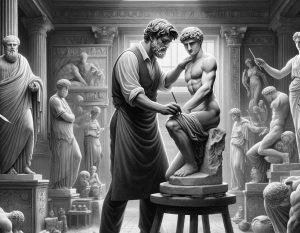Polycleitos Ancient Greek sculptor

Polycleitos’s work represents a shift towards the idealized, yet highly realistic representation of the human figure, with an emphasis on anatomical perfection, balance, and the dynamics of the body in space. His sculptures, which mainly depicted athletes, gods, and warriors, were renowned for their detailed precision, sense of balance, and the illusion of movement they conveyed.
While much of his original work has not survived, Roman copies and references in ancient texts have preserved the legacy of his artistic principles. Polycleitos’s influence extends beyond his own era, affecting not only the development of Greek sculpture but also the broader evolution of Western art, with his principles of symmetry and proportion being studied and revered by artists and architects throughout history.
Early Life and Training
Polycleitos, the renowned ancient Greek sculptor, had a fascinating early life that shaped his artistic vision. Born in Argos around 480 BC, little is known about his upbringing and family background. However, it is believed that he received formal training as a sculptor in the workshop of Ageladas of Argos.
Under the mentorship of Ageladas, Polycleitos honed his skills and developed a distinct style characterized by idealized proportions and intricate anatomical detail. His early works showcased a mastery of technique and a deep understanding of human form.
As he continued to refine his craft, Polycleitos gained recognition for his innovative approach to sculpture, eventually becoming one of the most celebrated artists of his time. His dedication to perfection and commitment to beauty set him apart from his contemporaries.
The rigorous training he underwent during his formative years undoubtedly played a crucial role in shaping Polycleitos into the visionary artist he would later become.
Major Works and Contributions to Art
Polycleitos, a renowned sculptor in ancient Greece, is celebrated for his major works that revolutionized the art of sculpture. His most famous piece, the Doryphoros (Spear Bearer), exemplifies his mastery of proportions and movement. The statue was admired for its idealized depiction of the male body, showcasing harmony and balance.
Another notable work by Polycleitos is the Diadumenos (Youth Tying a Fillet), which captures a moment of grace and poise in an athlete’s life. This sculpture highlights Polycleitos’ attention to detail and ability to convey emotion through marble.
In addition to his iconic sculptures, Polycleitos made significant contributions to art theory with his treatise on aesthetics called the Canon. This text outlined principles for creating perfect proportions in art, influencing generations of artists to come.
Polycleitos’ major works continue to inspire artists today with their timeless beauty and technical skill.
Impact on Greek Sculpture and Influence on Later Artists
Polycleitos, a renowned Greek sculptor from the 5th century BC, is celebrated for his significant impact on Greek sculpture and enduring influence on later artists. His mastery of proportions and attention to detail revolutionized the art form, setting new standards for anatomical accuracy and idealized beauty.
Polycleitos’ innovative techniques in sculpting human figures with harmonious proportions inspired generations of artists to come. His iconic work “Doryphoros” (Spear Bearer) exemplifies his dedication to portraying the perfect balance between tension and relaxation in the male form, influencing countless sculptors throughout history.
His emphasis on naturalistic poses and lifelike expressions paved the way for a more realistic representation of human anatomy in sculpture. Artists such as Praxiteles and Lysippus drew inspiration from Polycleitos’ principles, further evolving classical Greek artistry.
The legacy of Polycleitos continues to resonate in contemporary art practices, showcasing how his revolutionary approach continues to inspire creativity across cultures and centuries.
Controversies Surrounding Polycleitos’ Work
Polycleitos, a renowned Greek sculptor of the 5th century BC, was not immune to controversy despite his artistic mastery. One of the controversies surrounding his work revolved around his revolutionary Canon, a treatise on ideal proportions in sculpture. Some criticized Polycleitos for imposing strict mathematical rules on art, arguing that it stifled creativity and individual expression.
Another point of contention was the perceived emphasis on physical perfection in Polycleitos’ sculptures, particularly evident in his iconic Doryphoros (Spear Bearer). Critics claimed that this focus on idealized beauty perpetuated unrealistic standards and failed to capture the true essence of humanity.
Additionally, there were debates over whether Polycleitos truly achieved harmony and balance in his works or if they leaned too heavily towards rigid formalism. Despite these controversies, there is no denying the lasting impact of Polycleitos’ contributions to Greek sculpture and his influence on subsequent artists throughout history.
Legacy and Recognition in Art History
Polycleitos’ legacy in art history is undeniable. His innovative techniques and groundbreaking contributions have solidified his place as one of the most influential sculptors in ancient Greece.
Even centuries after his time, Polycleitos continues to inspire artists around the world with his mastery of form, proportion, and balance. His sculptures are a testament to his skill and vision, showcasing a level of perfection that still captivates audiences today.
Art historians recognize Polycleitos as a pioneer who pushed the boundaries of classical sculpture, setting new standards for future generations to aspire to. His influence can be seen in countless works of art throughout history, demonstrating the lasting impact he has had on the artistic world.
Despite some controversies surrounding his work, there is no denying the significance of Polycleitos’ contributions to art history. His legacy lives on through the timeless beauty and sophistication of his sculptures, reminding us of the enduring power of creativity and imagination in shaping our cultural heritage.
